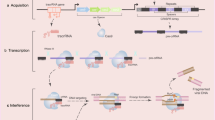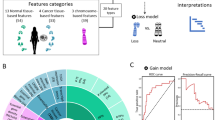Abstract
Induced expression of a mutant human Ha-ras oncogene in NIH3T3 cells leads to the rapid production of multicentric chromosomes, acentric chromosome fragments, double minute chromosomes, increased heteroploidy, and increased capacity to undergo gene amplification. In this study we have used fluorescent-in-situ hybridization (FISH) to demonstrate that induction of the Ha-ras oncogene also leads to disruption of the mitotic machinery, resulting in aberrant mitoses and abnormal daughter cells. Cells induced to express an oncogenic Ha-ras transgene accumulate chromosomes that lag outside of the rest of the chromosomal architecture, chromosomes that form bridges between daughter nuclei at anaphase, and that form micronuclei. Many of these mitotic aberrations contain structurally abnormal chromosomes. Theseras-induced changes were suppressed by the introduction of a gene encoding the dominant negative effector ofras, raf 301. Expression ofraf301 in cells induced to express Ha-ras reduced the level of growth in soft agar, chromosome aberrations, mitotic aberrations, and frequency of gene amplification. These data provide evidence for an association between Ha-ras induced transformation, chromosome aberrations and gene amplification. Furthermore they offer insight into how the cell responds to the formation of aberrant chromosomes, and how disrupting chromosomal architecture could lead to further imbalances in the distribution of genetic material between daughter cells.
Similar content being viewed by others
Literature Cited
Solomon, E., Borrow, J., and Goddard, A.D. (1991).Science,254:1153–1160.
Hartwell, L. (1992).Cell,71:543–546.
Schnipper, L. (1986).The New England Journal of Medicine,314:1423–1431.
Livingstone, L.R., White, A., Sprouse, J., Livanos, E., Jacks, T., and Tlsty, T.D. (1992).Cell,70:923–935.
Yin, Y., Tainsky, M.A., Bischoff, F.Z., Strong, L.C., and Wahl, G.M. (1992).Cell,70:937–948.
Lipkowitz, S., Garry, V.F., and Kirsch, I.R. (1992).Proc. Natl. Acad. Sci. USA,89:5301–5305.
Setlow, R.B. (1978).Nature,271:713–717.
Kastan, M.B., Onyekwere, O., Sidransky, D., Vogelstein, B., and Craig, R.W. (1991).Cancer Research,51:6304–6311.
Parada, L., Tabin, C., Shih, C., and Weinberg, R. (1982).Nature,297:474–478.
Denko, N.C., Giaccia, A., Stringer, J.R., and Stambrook, P.J. (1994).Proc. Natl. Acad. Sci. USA,91:5124–5128.
Wani, M., Xu, X., and Stambrook, P.J. (1994).Cancer Research,54:2504–2508.
Bos, J. (1989).Cancer Research,49:4682–4689.
Boguski, M., and McCormick, F. (1993).Nature,366:643–653.
Bokoch, G.M., and Der, C.J. (1993).FASEB,7:750–759.
Gibbs, J.B., Sigal, I.S., Poe, M., and Scolnick, E.M. (1984).Proc. Natl. Acad. Sci. USA,81:5704–5708.
Johnson, G.L., and Vaillancourt, R.R. (1994).Current Opinions in Cell Biology,6:230–238.
Bruder, J.T., Heidicker, G., and Rapp, U.R. (1992).Genes and Development,6:545–556.
Hagag, N., Diamond, L., Palermo, R., Lyubsky, S. (1990).Oncogene,5:1481–1489.
Liu, H.S., Scrable, H., Villaret, D.B., Lieberman, M.A., and Stambrook, P.J. (1992).Cancer Research,52:983–989.
Sidranski, D., Tokino, T., Hamilton, S.R., Kinzler, K.W., Levin, B., Frost, P., and Vogelstein, B. (1992).Science,256:102–103.
McClintock, B. (1951).Cold Spring Harbor Symposia on Quantative Biology,16:13–47.
Koong, A.C., Chen, E.Y., Mivechi, N.F., Denko, N.C., Stambrook, P., and Giacca, A.J. (1994).Cancer Res.,54:5273–5279.
Weier, H.U., Zitzelsberger, H.F., Gray, J.W. (1991).Biotechniques,10:498–505.
Cornforth, M., and Goodwin, H. (1994).Radiation Research,126:210–217.
Nicklas, R.B., Krawitz, L.E., and Ward, S.C. (1993).J. Cell Sci.,104:961–973.
Gloushankova, N.A., Lyibonova, A.V., Tint, I.S., Feder, H.H., Vasiliev, J.M., and Gelfand, I.M. (1994).Proc. Natl. Acad. Sci. USA,91:8597–8601.
Dartsch, P.C., Ritter, M., Haussinger, M., and Lang, F. (1994).Europ. J. Cell. Sci.,63:316–325.
Windle, B., Draper, B.W., Yin, Y.X., O'Gorman, S., and Wahl, G.M. (1991).Genes and Development,5:160–174.
Willard, H.F. (1990).Trends in Genetics,6:410–416.
Haaf, T., Warburton, P.E., and Willard, H.F. (1992).Cell,70:681–696.
Earnshaw, W.C., Ratrie, H., and Stetten, G. (1989).Chromosoma,98:1–12.
Wandall, A. (1994).Chromosoma,103:56–62.
Nobes, C., and Hall, A. (1994).Curr. Opin. Genet. Dev.,5:77–81.
Matuoka, K., Shibasaki, F., Shibata, M., and Takenawa, T. (1993).EMBO J.,12:3467–3473.
Nelson, W.G., and Kastan, M.B. (1994).Molecular and Cellular Biology,14:1815–1823.
Smith, K.A., Stark, M.B., Gorman, P.A., and Stark, G.B. (1992).Proc. Natl. Acad. Sci. USA,89:5427–5431.
Toledo, F., Le Roscouet, D., Buttin, G., and Debatisse, M. (1992).EMBO,11:2665–2673.
Ma, C., Martin, S., Trask, B., and Hamlin, J.L. (1993).Genes and Development,7:605–620.
Author information
Authors and Affiliations
Rights and permissions
About this article
Cite this article
Denko, N., Stringer, J., Wani, M. et al. Mitotic and post mitotic consequences of genomic instability induced by oncogenic Ha-Ras . Somat Cell Mol Genet 21, 241–253 (1995). https://doi.org/10.1007/BF02255779
Received:
Accepted:
Issue Date:
DOI: https://doi.org/10.1007/BF02255779




